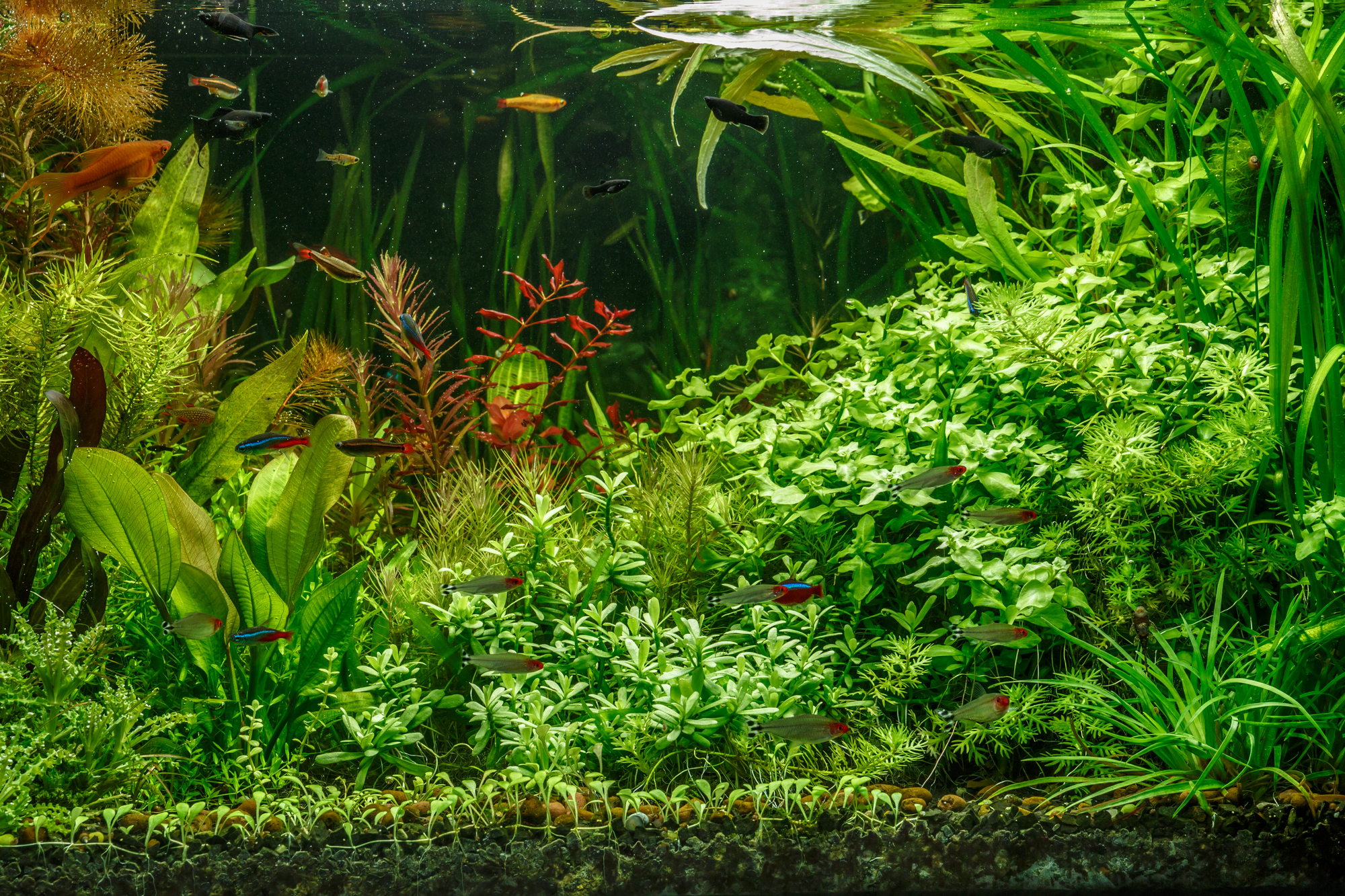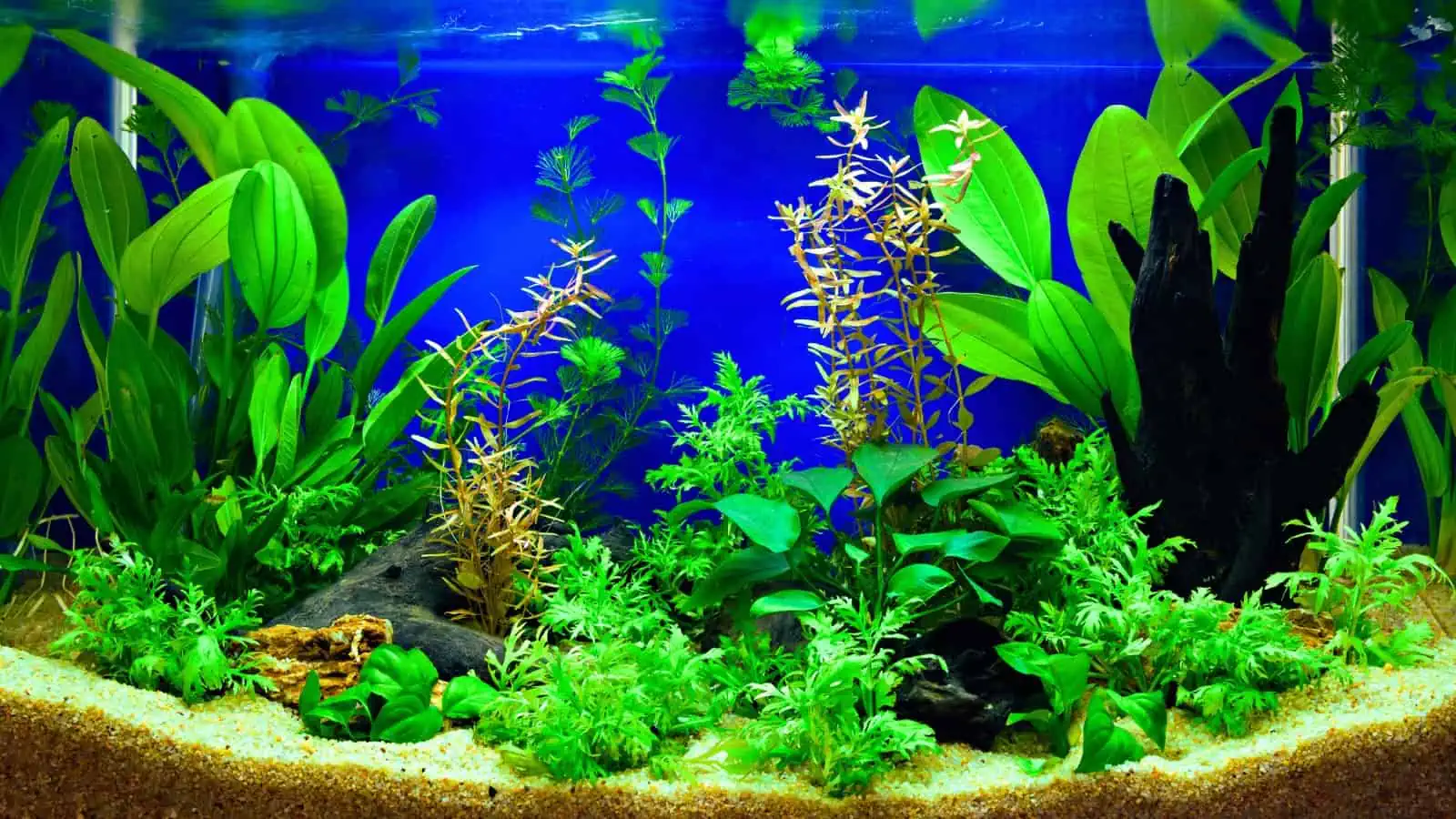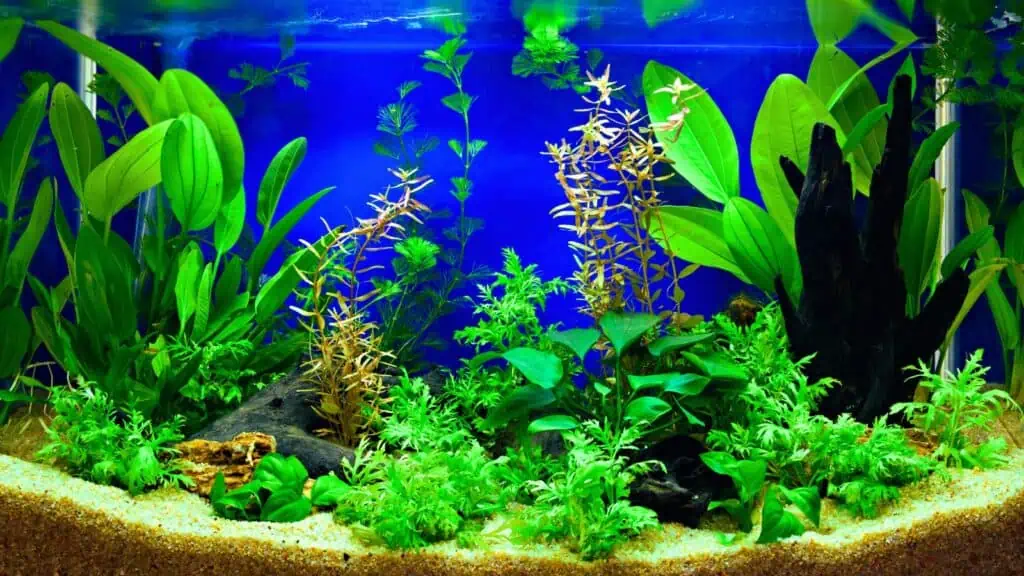When I bought my first aquarium, I was daunted by the prospect of growing live plants. Although my fears were unfounded, I opted to launch my fishkeeping career purely with plastic replicas.
Later on, my uncle introduced me to the ever-resilient Amazon Sword and I never looked back. Aquarium plants are not only easy to keep but can create a stunning tank that can’t be matched by artificial alternatives.
Here we’ll take a closer look at the advantages and disadvantages of keeping live plants to make it easier to choose the best option for you.
Key Takeaways
- Live aquarium plants provide a huge range of benefits such as keeping the water clean, providing hiding places, producing oxygen, and adding interest and beauty.
- A few drawbacks of keeping live plants include maintenance tasks and making the tank slightly more difficult to clean.
- On balance, live plants make an easy and fascinating addition to most freshwater aquariums, although there are a few setups where they’re incompatible.
The Pros of Keeping Live Plants
Beauty and Interest
Aside from the myriad benefits of live plants that you’ll soon discover, my number one reason for recommending real plants is that a well-planted tank can be an extremely beautiful, fascinating environment that can’t be matched by plantless aquariums.
The art of arranging a beautifully decorated aquarium is known as aquascaping, and the key component of most aquascapes is live plants.
By combining several species of plants with different sizes, shapes, and colors, an enchanting underwater world is created that simply outperforms any fake plant alternatives.
Provides Hiding Places
Another great advantage of densely planted tanks is the sheer number of hiding places that the foliage provides for your fish and invertebrates.
While some fish prefer plenty of open water to swim around in, other species are more secretive and need abundant places to hide. Live plants help remind fish of their natural habitats, making them feel calm, relaxed, and more at home.
Feeling less stressed is a huge asset to your fish’s health, and they’ll reward you with brighter colors, flamboyant displays, and longer lifespans.
Convert Carbon Dioxide to Oxygen (In the Daytime)
During the daytime, as live plants photosynthesize, they absorb dissolved carbon dioxide and expel dissolved oxygen into the water.
This is the perfect match for fish and other aquatic pets that breathe in oxygen and breathe out carbon dioxide. Put simply, your plants provide oxygen for your fish, and your fish provide carbon dioxide for your plants. Isn’t nature ingenious?
This does come with a caveat, however. During the night, plants reverse this gas exchange by absorbing oxygen and expelling carbon dioxide. We’ll discuss this point further in the ‘Cons of Live Plants’ section below.
Reduces Nitrates in the Aquarium
If you’ve been keeping fish for long, you’ll probably know that high nitrate levels signal poor water quality. Nitrate levels above 20 ppm can be dangerous to your fish and invertebrates, which is one of the reasons that testing your aquarium water regularly is such a good idea.
Luckily, nitrates are one of the most important macronutrients for plant growth, and high nitrate levels often simply make plants grow even faster.
By absorbing nitrates from the water and converting them into living tissue, well-maintained live plants do a fantastic job of reducing nitrates in the water.
Absorb Toxins From the Water

In addition to absorbing carbon dioxide and nitrates for the aquarium, live plants absorb other harmful toxins, too.
Although there is much misunderstanding on the topic, plants absorb not only nitrates from the water but also ammonia and nitrites which are extremely toxic to fish.
In addition to nitrogenous compounds, aquatic plants can also absorb heavy metals such as copper and lead that could otherwise be harmful to your fish and especially to invertebrates like snails and shrimp.
Inhibit Algae Growth
By absorbing nutrients such as nitrates and phosphates from the water column, live plants help to inhibit the growth of algae which would otherwise prosper on these nutrients.
Additionally, tall live plants and floating create a dappled shading effect underneath which further hampers the algal growth. Let’s talk more about that dappled lighting effect.
Creates Dappled Lighting
While some fish would naturally swim in open water under direct sunlight, others come from shady habitats such as forest streams where they would rarely be exposed to bright lights.
These types of fish may suffer from stress and health problems if kept under bright aquarium lights every day, so growing plants to create shade can be a vital part of keeping them feeling happy and healthy.
Floating plants such as Amazon Frogbit and Water Sprite are especially useful in this role.
Source of Food
Live aquarium plants can also be a useful source of food for your fish. Many fish species are herbivorous, so aquatic plants make a natural part of their diet.
While a keen appetite for live plants can occasionally cause problems, most plant-eating fish won’t damage plants enough to do substantial damage.
Provide a Breeding Habitat
Some aquarists install certain plant species specifically to provide a breeding habitat for their fish.
While certain species of fish don’t require plants to breed, others lay adhesive eggs that are specially designed to stick to plant foliage.
Fish species like gouramis and betta fish that build bubble nests also find floating plants extremely helpful to give support and structure to their nests.
When fish fry hatch from their eggs, they may also find dense, feathery plants such as Java moss an excellent habitat to hide in, away from larger fish or even their parents which may prey upon them.
The Cons of Keeping Live Plants
Knowledge Required
One aspect that may deter some beginners from keeping live plants is the extra knowledge required to keep them. But this doesn’t have to be so!
While some aquatic plants do indeed demand some experience to keep them alive and healthy-looking, many others are so robust as to be almost fool-proof!
Easy plants like Java Fern, Java Moss, Anubias, and Amazon Sword are so easy to grow, that there’s little more to it than stabbing their roots into the aquarium substrate, giving them adequate lighting, and watching them romp away.
Maintenance
One of the more legitimate reasons that some people will choose not to keep live plants is the extra maintenance they require.
Again, better-behaved types of plant shouldn’t require much extra work from the aquarist, but occasional pruning and removal of dead leaves is usually inevitable.
Dead Leaves and Water Quality

Speaking of dead leaves, well, what happens if you don’t remove them? If left to rot, dead leaves from aquatic plants will release the same toxic nitrogenous compounds like ammonia and nitrites that a dead fish or uneaten fish food releases.
If you have a well-cycled aquarium, these should be converted by beneficial bacteria in your tank relatively quickly. Additionally, some species of shrimp, snails, and fish may eat up dead plant leaves, leaving you with one less thing to do.
Incompatible Fish
Although I’m a big fan of live plants, there are a few instances where they’re simply incompatible with certain fish species.
Fish species such as silver dollars, goldfish, earth eaters, and Oscars are renowned for tearing up aquarium plants – either for eating or simply by their boisterous attitude towards anything in their tank!
In these cases, artificial plants, securely anchored in the substrate might be your only option.
Lower O2 Levels at Night
As I mentioned earlier, aquatic plants reverse their normal gas exchange during the night to absorb oxygen and excrete carbon dioxide.
Because this is the same gas exchange process as your fish and invertebrates, oxygen levels may become significantly lower during the night.
If you notice your fish gasping at the water’s surface when the aquarium lights are off, it may indicate that your plants are absorbing too much oxygen during the night.
This problem can be overcome either by cutting your live plants back, cleaning your tank thoroughly to reduce microbial activity, or by installing a more effective filtration or aeration system to supply more oxygen.
Makes Tank Cleaning More Challenging
Another reason that some people may opt to go for a plant-free aquarium is that such setups are easier to clean.
When vacuuming the aquarium substrate, live plants and their roots can sometimes create an obstacle and make it more fiddly to clean effectively.
This is why breeding tanks and hospital tanks are sometimes free from plants or simply feature plastic plant alternatives.
On the other hand, well-maintained plants actively clean the water and support beneficial bacteria that remove toxins.
Conclusion
After weighing up the pluses versus minuses of keeping live aquarium plants, I’m definitely sticking with my opinion that there are far more pros than cons!
While some aquarium plants can be tricky to keep, there are plenty of easy species that almost every fish keeper can keep in almost any type of setup.
By cleaning the water, providing hiding places, and simply looking stunning, live plants deserve to be tried by every aquarist out there.



I have a 10 gallon planted Aquarium (green and red crypts, and one Anubias nana) with sand substrate that has been up for a year. For some reason recently, despite the weekly water changes and siphoning with my gravel vacuum, there is still a bunch of light brown junk floating around that eventually clings to my filter intake And the sides of my tank. I have also changed and cleaned the filter as well.
The fish I have are: one male half moon betta, a few ghost shrimp, one otocynclus (had one more but it died recently and I don’t want to introduce more into the tank until I get this dirt figured out), 1 Apple snail, and 2 peppered cory cats (I took 2 from my school of 6 in my 36 gal tank to see if they could help move the sand around and keep it cleaner but it’s not really working. So I’ll probably move them back to their school) .
I didn’t know if the reason it is getting so dirty so fast is because of the sAnd, the fish, the plants, or what.
I don’t have this problem in my tropical community 36 gal with gravel and plants.
If you have any suggestions, I would be eternally greatful!
Hi!
That sounds like an odd problem. With the apple snail, I think the tank is a little overstocked. I’m not sure at all if that’s the cause, but I would keep the stock at the betta, shrimp and 4-5 otocinclus. Apple snails produce a LOT of waste, especially when they start growing larger – up to the size of a golf ball.
It’s really difficult to “diagnose” this without a photo. If you google “freshwater aquarium diatoms”, is that it? Or is it loose dirt-ish stuff? If that’s the case, do you rinse your filter media regularly? Are you sure there are no “forgotten” spots where dirt collects which is then disturbed when doing a water change? Does one of the plants have rotting leaves? If it’s not anything like that, you can try mailing a photo to aquariadise(at)gmail(dot)com so I can have a look 🙂